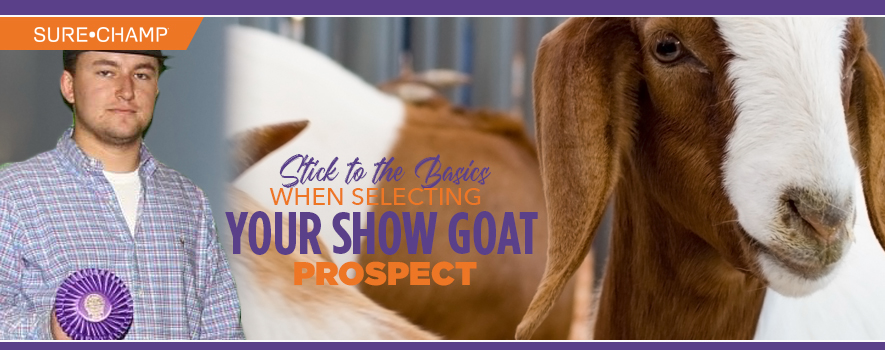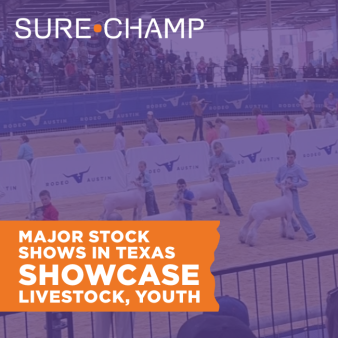
Showing market goats has grown in immense popularity during the past two decades. As the competition has become more popular, the number of high-quality breeders has increased and the quality of show wethers has improved as a result of that. But, what should you look for in a show goat that can get you to the backdrop? Cooper Bounds, Maryland native who started showing wether goats in the 2000s, led the Grand Champion Market Wether at the 2012 American Royal. He is the assistant livestock judging coach at Western Illinois University and shares his tips for selecting the right project goat for you.
Like anything you are going to attempt, Bounds suggests finding a mentor to help you with your goat selection. This same mentor can advise you with feeding, grooming and showmanship advice. Find someone – an ag teacher, judging coach, breeder or other expert who can guide you through the process. Choose someone you’re comfortable with that you trust. And remember, to become successful, this person will likely be both your biggest cheerleader and critic.
Both you and your mentor need to build relationships with the breeder or seller of the show prospects you are scouting. This will be to your advantage, as each breeder will have a more definite understanding of his or her herd’s bloodlines and the growth and maturity rates of the respective kids.
Bounds said when he is helping someone with wether project selection, the most important question he asks the potential exhibitor is what kind of feeding style they utilize. Although some less experienced exhibitors might not know how that will impact their project selection, Bounds said it can play a vital role in the selection process.
“We need to find an animal that fits the feeder. Some people are better at pushing them, and some are better at maintaining them so in terms of mass and body condition, when they purchase their animals, it will vary by their feeding style,” he said. “If they are better at maintaining and not pushing, then we are going to want to get ones that are a little chubby and pretty stout and muscular. I probably am not going to send a skinny, green one to guys like that. On the flip side, if we have a family that really likes to feed hard and they are wanting to go to a show in the fall, a state fair in September or October or even to Louisville, they probably don’t need to be purchasing a 75-pounder to go to a deal like that.”
Visual Appraisal
“When I go into a pen of goats, I study those things from the outside first. Make sure joints all go the right way, they are balanced, attractive and good built. We like to find ones that are fault-free and will hit a wide variety of judges. You don’t want to purchase animals that have glaring issues, but are really good in certain areas, if we don’t think those issues will self-correct over time. You don’t want to spend a bunch of money on one, and an issue you identified at the get-go is still an issue four to five months down the road,” Bounds said.
He suggests visually inspecting a goat is a good place to start on your goat selection journey. Since goats do grow and develop so differently and each has a different maturity pattern and growth rate, it is important to keep those things in mind, and rely on your mentor or the breeder for advice on how one animal might grow versus another. Look for kids that are wide and square with a big rib cage, which correlates to top-side mass. Make sure they are straight in their lines, proportional in their piecing, stylish in their design with a long neck and tall front.
“I look for balance, eye appeal and pen presence – stoutness of skull, jaw line, how they hold their ears. Typically, if you study those things, they get along better later in life. Long ears aren’t bad, but short ears are more eye-appealing, and makes them look freakier and more extended,” Bounds suggested.
Get a Grip
After he finds show prospects that meet his visual criteria, Bounds likes to get them braced and handle them. Handling them properly allows for a truer evaluation of potential for muscle shape and growth.
“If you are going to go in and handle, you will be able to identify actual shape to the rib cage, something people have a little more issue identifying on babies. The chubbier ones aren’t always the best in terms of their rib cage. If we can identify ones that are assembled right in term of their rib cage and how their skeleton lies together rather than just reading baby fat, you can usually get along quite a bit better as they mature,” he said.
Make them Move
The final and perhaps most important criteria in selecting a show prospect is to see them on the move, which is often how judges will evaluate your stock. If the wether prospect doesn’t move correctly, chances are he isn’t as good as you might think, nor does he have the potential to develop correctly. When he is walking, make sure loin edges are flat, high and square, while the jump muscles are not super apparent. Those are all traits that should smooth out with maturity.
“Ones that grab our attention, we’ll prop it up and then drive. They might look fine in terms of shoulder blade, joints and squareness on the standstill, and then there are some that might hock in just a skosh when they drive or don’t put weight on their feet evenly when they drive. Some of those things, like neck attachments might be different between bracing and walking around and vice-versa. You want one that will look just as good walking around as you do when bracing and vice-versa,” Bounds emphasized.
Just like with any activity or livestock you will show, trends will come and go. But for Bounds, he suggests sticking to the basics of evaluation: visual appraisal, handling and evaluating structure on the move. Know your feeding management program, find a mentor and enjoy looking at good stock along the way to purchasing your next show prospect.
“To be involved in the last decade and watch it morph into what it is now has been pretty impressive,” Bounds said.

